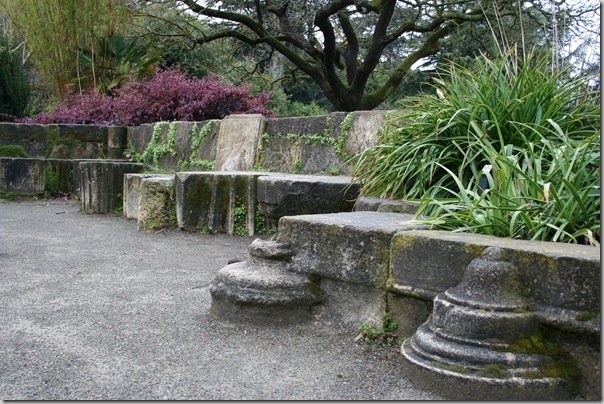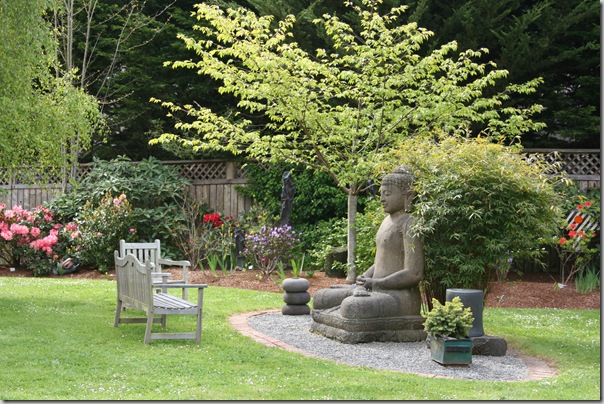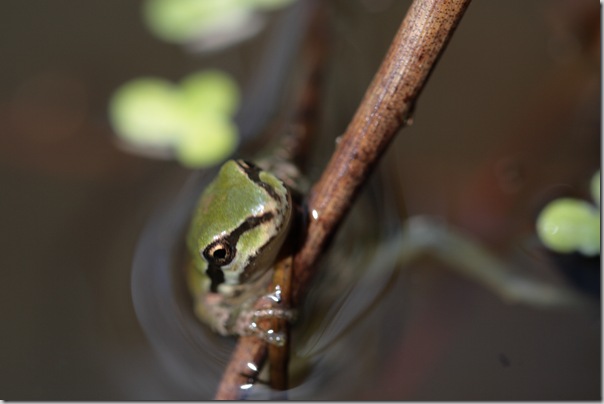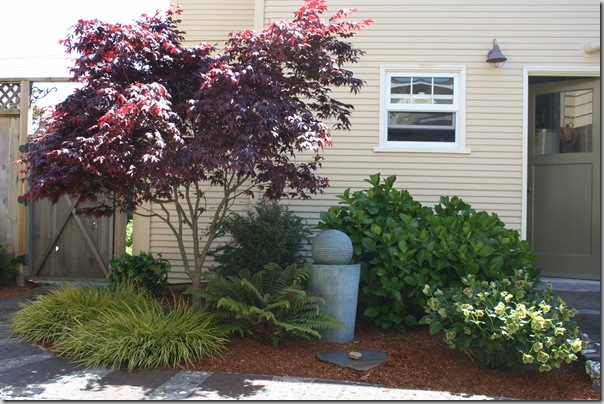When creating a space for calm contemplation, what you leave out is much more important than what you put in. It’s as true in the garden as it is elsewhere; clutter isn’t soothing. Whether you’re creating a small nook for restful solace or overhauling an entire garden, these essential elements will keep you on track when designing a space for serenity.
Repetition

Repetition of materials and plants sets a soothing scene at the San Francisco Strybing Arboretum.
Planting en masse is one of the easiest ways of creating a soothing environment. You know how we feel such a sense of awe and majesty when faced with the ocean or a prairie-like field of swaying grasses? You can mimic that feeling in your own garden by planting drifts of the same plant. That old saying that you should plant in threes isn’t nearly expansive enough if your goal is a contemplative space. Use lots of the same plant and carry them through an entire bed, with just a few friendly companions for color or textural contrast.
You should also use repetition in your choice of materials. The one-of-this, one-of-that mentality is fun while you’re actually at the garden shop, but you’ll be happier with your final space if you go more minimalist in your color and material selections.
Focal points

This Javanese statue in the Mullen garden in Eureka, CA needs little accessorizing to draw the eye.
Of course, all that about repetition can go out the window somewhat in your focal areas. While your focal areas should be a reflection of the surroundings, the fact is that mixing it up draws the eye, and don’t you want to rest your eyes on a bold, perfectly-balanced planting or a meaningful piece of art while relaxing?
Leaving your eyes to drift aimlessly around isn’t a recipe for calm. The reason that repetition works elsewhere is that it allows your focal areas to take center stage. Choose big leaves, bold markings, or a sculpture, stone or water feature that feels meaningful and beautiful to you. By using a little more variety in your focal area, your eye will be drawn from the simple lines and plantings around, to the interest and excitement of the display you’ve created.
And don’t be afraid to change things until you get it right. Your focal area should sing to you; if it doesn’t, either go bolder and simpler until it does, or add another element to highlight what you have. Listen to your gut and let intuition guide your decisions, as contemplative spaces are personal and should reflect your own spirit and tastes.
Wildlife and animals

A frog enjoys this garden pond, and the resulting ribbits, croaks and splishes bring a childlike sense of awe into the garden.
There’s something about seeing a hummingbird, dragonfly or frog in the garden that transports me back into childhood for a wild, wonderful few moments. Interaction with the creatures in our lives can take many forms.
Maybe your contemplative space will include nectar-producing plants so you can enjoy the buzzing of native bees and the occasional sipping hummingbird. Perhaps you’d like to invite your cat to enjoy nature with you by placing a few ornamental grasses or vase-shaped shrubs for them to nap under. Or maybe you’ll take Jessi Bloom’s advice and invite chickens into your contemplative space with a mirror, forage greens, or dust bath area so they can play within your view?
In any case, inviting wildlife into your garden and creating room to spend happy time with your animal companions can be a great recipe for a truly meaningful outdoor space.
Ditch the clutter

This serene, clutter-free garden bed is the primary scene from an indoor window, creating a contemplative space to enjoy from inside.
Whether it’s the usual garden errata that we all have lying about (hose, tools, extra materials), or the décor items that aren’t your favorite but are hard to let go of, try to stash, declutter and minimize at every turn. Looking at clutter is like staring at a to-do list; your mind races and it doesn’t allow you to be at one with your space.
Stash hoses in attractive hose pots. Build small garden walls or fences to hide potting soil bags or other materials, or create a cute shed. Many designers employ built-in benches as sneaky storage for garden tools. The bench itself can be the lid to a storage box that can keep excess accessories under wraps.
Pots are best kept to just a few very large ones. If you have more than three pots in an area, ask yourself exactly what impact you’re trying to have and whether you might be able to create a stronger effect with fewer, larger pots that all share a similar color, shape and material. An 18″ pot is the smallest I’d consider using in a garden, and I’d use a pot that small only as an accessory to a larger partner. Big pots let you make a big impact.
Use sound

The rustling of this bamboo in the Duncan garden in Eureka, CA helps screen neighborhood noises while setting the scene.
At the San Francisco Garden Show last week, I met a fellow named Hugh Livingston who created the sound effects for one of the gardens. I had never heard of that before, but do you know what everybody seemed to like the best about this garden? It was an experience. Stepping into the display was like stepping into another world. Hugh offers a service called Sound Cocoon, which reduces traffic noise in the garden, as well as other sound effects that can transform your garden into a real retreat.
Stepping into your contemplative space should be an experience of its own. Whether you have a small water feature, a gong to ceremoniously tap as you walk by, or simply the rustling of foliage and the tweetles of birds, sound can be a major part of creating that experience. Let’s face it; there’s nothing soothing about hearing your neighbors argue about taking out the trash – again. A little distraction can be a good thing!
Of course, these are just a few of the elements that make a contemplative space tick. Check out the views of my fellow designers of the Roundtable for a varied set of takes of this topic:
Lesley Hegarty & Robert Webber : Hegarty Webber Partnership : Bristol, UK
26 responses to “Contemplative Spaces: Key Elements To Include”
[…] Genevieve Schmidt : North Coast Gardening : Arcata, CA […]
Awesome points on how really to get the mood!
LOved your point about planting both en masse and in detail. How many people get the change of pace which is needed.
Loved the idea of a gong to tap!
Best
R
Thanks, Robert! Your comments are much appreciated. . .
Gen, I love how you point out that classic design details like repetition and focal points make for not only good design, but a calming environment. Great ideas!
Thank you, Jenny. For my part I loved your tips about labyrinths and other super-cool elements that one can install to aid contemplation and slowing down. Good stuff!
Tons of great stuff here! The points that resonated most with me were 1) to clean up your gardening crap! It seems like we gardeners should be setting a great example with attractive landscapes and yet so often those of us who love our yards the most are the ones who are the worst about leaving our junk all over, and 2) your remark about pots — how just a few bigger pots are so much more aesthetic and restful than tons of tiny ones. Never really thought of that, but that bit of advice is really going to stick with me. Thanks, Gen!
Thanks, Mary! Yes, I’m starting to get snooty about the tools I pick up, too. I want them to be attractive as I know SOME of them simply won’t get put away all the time (hose, I am lookin’ at you). My partner Trevor even painted the handle of his rake to make it more stylish!
Jen: fabulous ideas on how to focus and declutter. Heading out to throw some things away right now.
Brill!
Great advice, Gen. Love this: “what you leave out is much more important than what you put in.” Well said!
Thank you! That’s like my new life motto. Perhaps if I repeat it I will follow it!
I would really love the big Buddha – suspect he would not fit in my suitcase! And like Susan, I very much agree with “what you leave out is much more important than what you put in.” Very well said indeed!
I started thinking about creating my own Meditation garden. Thank you so much for the tips.
I am glad. We all need a space to find solace and peace.
Every garden needs a place to rest the eye. Thanks for the great post.
-Susan
Thank you, Susan.
It’s no longer Strybing but now San Francisco Botanical Garden!
The San Francisco Botanical Garden Society is planning a horrific new office building that will destroy the place!
http://kalwnews.org/community/blog/2011/09/14/we-do-not-need-office-building-golden-gate-park_1245683.html
Well I thought so, but I got hoitily corrected by a SF friend! Thanks for setting me straight!
It’s fascinating that you used some traditional design points (massing, focal points, editing) as a means to describe a contemplative space while avoiding cliches about more traditional contemplative spaces (Zen gardens, etc). I like that. You don’t have to have a labyrinth or Japanese style garden to have something contemplative; instead, it can arise out of almost any garden style.
Thanks, Thomas! I love labyrinths and zen gardens, but honestly, in a small suburban garden a lot of us just don’t have the desire to give the whole space over to a theme, but I do feel that with good design we can still quite easily have a lovely space to rest our minds.
Fantastic! Great ideas here, Gen, that could apply to any well designed garden. I especially liked your point about creating a focal point that has personal meaning. That concept could also be embraced when selecting plants, hardscape materials, color accents, etc. Thanks for the inspiration!
Thanks, Jocelyn! I love bringing personal meaning to the gardens I design. Often clients don’t have a lot of ideas initially about how to do that, but those thoughts do seem to emerge during the process, and it makes me really happy to be able to incorporate those personal touches in.
Gen, thank you for such a thorough breakdown of how a home gardener can create a contemplative space in their own garden. I’m currently helping a client create one of her own, and will absolutely be sending her your article!
Rebecca, I am honored. Thank you so much!
Thank you for the wonderful tips and ideas! The garden as a place to contemplate and “experience” is just what I’m after!
Terrific tips and reminders. Love the way you conveyed the topic.